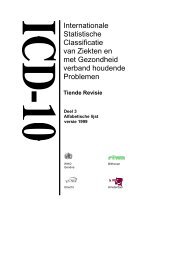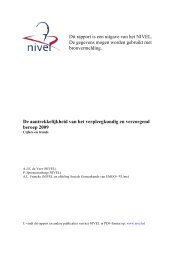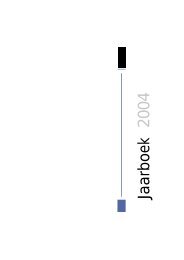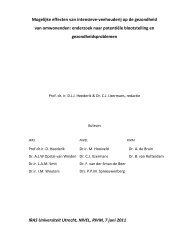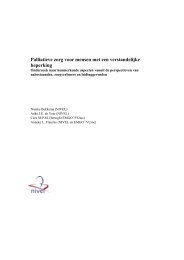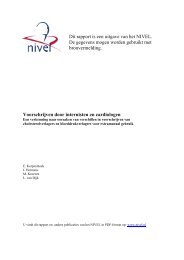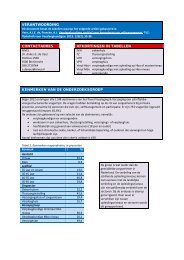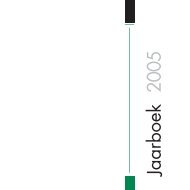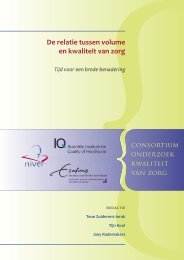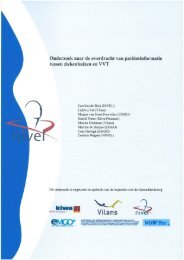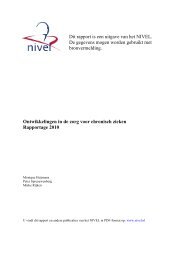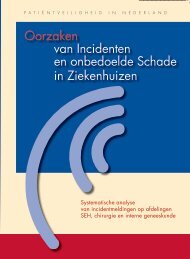- Page 1 and 2: Dit proefschrift is een uitgave van
- Page 3 and 4: Multi-Sensory Stimulation in 24-hou
- Page 5: niet naakt maar ontbloot het ontgli
- Page 8 and 9: 8 Multi-Sensory Stimulation in 24-h
- Page 10 and 11: Introduction The study described in
- Page 12 and 13: equire special services such as the
- Page 14 and 15: the biomedical nature of dementia a
- Page 16 and 17: Holtkamp et al., 1997; Kragt et al.
- Page 20 and 21: a decrease of negative instrumental
- Page 22 and 23: measurements on the experimental an
- Page 24 and 25: Figure 1.3 Design of the study Mont
- Page 26 and 27: Chapter 2 to 7 are submitted for pu
- Page 28 and 29: 2 A systematic review The effects o
- Page 30 and 31: International Psychogeriatric Assoc
- Page 32 and 33: Table 2.1 Included methods Behaviou
- Page 34 and 35: Table 2.2 Criteria List for the Met
- Page 36 and 37: The Best Evidence Synthesis is cond
- Page 38 and 39: This section describes the features
- Page 40 and 41: Treatment type and first author Val
- Page 42 and 43: and first author (N; sex; age) seve
- Page 44 and 45: -table 2.5 continued V- Treatment t
- Page 46 and 47: Treatment type and first author Psy
- Page 48 and 49: The second control group continued
- Page 50 and 51: the day hospital, an occupational t
- Page 52 and 53: One included study researched the e
- Page 54 and 55: There is limited scientific evidenc
- Page 56 and 57: Another point related to the focus
- Page 58 and 59: Abstract Many intervention studies
- Page 60 and 61: characteristics of the programme (i
- Page 62 and 63: implementation process and the resu
- Page 64 and 65: Study group On the last day of trai
- Page 66 and 67: Questionnaire In order to identify
- Page 68 and 69:
Table 3.1 Caregivers’ opinion abo
- Page 70 and 71:
Nursing home (H) Facilitating facto
- Page 72 and 73:
In four homes, the study group had
- Page 74 and 75:
‘An obstacle was formed by centra
- Page 76 and 77:
patient outcomes. There were two pr
- Page 78 and 79:
interventions in the organisational
- Page 80 and 81:
centred work environments’, as de
- Page 82 and 83:
4 Effects of snoezelen, integrated
- Page 84 and 85:
Introduction Effective communicatio
- Page 86 and 87:
The following research questions wi
- Page 88 and 89:
Subjects Residents To establish the
- Page 90 and 91:
CNAs was employed in the ward at pr
- Page 92 and 93:
Table 4.1 Nonverbal categories of t
- Page 94 and 95:
-table 4.2 continued Instrumental c
- Page 96 and 97:
the mean frequency of ‘smiling’
- Page 98 and 99:
Follow-up Allocation Enrollment Ana
- Page 100 and 101:
The table shows that the experiment
- Page 102 and 103:
Table 4.5 Change in nonverbal commu
- Page 104 and 105:
Table 4.6 Change in verbal communic
- Page 106 and 107:
Table 4.7 Change in verbal communic
- Page 108 and 109:
Conclusion and discussion Results T
- Page 110 and 111:
Strengths and limitations The findi
- Page 112 and 113:
communication despite demented resi
- Page 114 and 115:
Abstract Background. Caregivers in
- Page 116 and 117:
Background The intervention (implem
- Page 118 and 119:
In particular, it was hypothesized
- Page 120 and 121:
In the pre-test, 124 video-recordin
- Page 122 and 123:
Enabling Giving the resident the op
- Page 124 and 125:
Pearson correlation of 25 (10%) vid
- Page 126 and 127:
change scores indicate a change in
- Page 128 and 129:
- table 5.2 continued - Outcome mea
- Page 130 and 131:
they were considered particularly i
- Page 132 and 133:
dementia, which can be used by staf
- Page 134 and 135:
138 Multi-Sensory Stimulation in 24
- Page 136 and 137:
Abstract Objectives: To investigate
- Page 138 and 139:
2002; Sambandham and Schirm, 1995).
- Page 140 and 141:
Randomization took place at ward le
- Page 142 and 143:
eak) (Van Weert et al., 2004). Inte
- Page 144 and 145:
The caregivers were offered three i
- Page 146 and 147:
internal consistency (Cronbach’s
- Page 148 and 149:
The number of wards was too small t
- Page 150:
Background characteristics Table 6.
- Page 153 and 154:
* p< .05, ** p< .01 a The scores in
- Page 155 and 156:
- table 6.3 continued - Outcome mea
- Page 157 and 158:
al., 2002). The within-session impr
- Page 159 and 160:
Effects on resident's behaviour 163
- Page 161 and 162:
Abstract Background: Dementia among
- Page 163 and 164:
new model, reflecting the relations
- Page 165 and 166:
considerations (e.g., the presence
- Page 167 and 168:
working life. Outcome measures ‘Q
- Page 169 and 170:
value calculated from the valid ite
- Page 171 and 172:
Enrollment Allocation Follow-up Ana
- Page 173 and 174:
The table shows that the experiment
- Page 175 and 176:
Psychological outcomes The effects
- Page 177 and 178:
Table 7.4 Change in outcome measure
- Page 179 and 180:
Table 7.4 provides the adjusted est
- Page 181 and 182:
model takes into account the data o
- Page 183 and 184:
8 Summary and discussion Summary an
- Page 185 and 186:
analysis, which implied more power
- Page 187 and 188:
informal reciprocal consultation wa
- Page 189 and 190:
To study the adherence of CNAs to t
- Page 191 and 192:
Discussion Theoretical reflections
- Page 193 and 194:
The effects of improved quality of
- Page 195 and 196:
The results of the present study gi
- Page 197 and 198:
direction. Qualitative as well as q
- Page 199 and 200:
Schrijnemaekers, 2001; 2002). They
- Page 201 and 202:
This study helped to answer relevan
- Page 203 and 204:
The practical and complex methodolo
- Page 205 and 206:
expected. In the experimental group
- Page 207 and 208:
observation scale that included pos
- Page 209 and 210:
Stimulus preference screening and c
- Page 211 and 212:
Samenvatting In dit proefschrift wo
- Page 213 and 214:
Om de effecten van snoezelen op de
- Page 215 and 216:
van gewoontes. De follow-up bijeenk
- Page 217 and 218:
tijdsinvestering gedaan wordt op zo
- Page 219 and 220:
In hoofdstuk 7 zijn de effecten van
- Page 221 and 222:
ewonersgerichte houding van verzorg
- Page 223 and 224:
Samenvatting 233
- Page 225 and 226:
Ballard C, O’Brien J, James I, My
- Page 227 and 228:
Burns A. Psychotherapy in Alzheimer
- Page 229 and 230:
versus usual care to demented elder
- Page 231 and 232:
Grol RTPM, van Everdingen JJE, Casp
- Page 233 and 234:
observatiekliniek voor ouderen [Val
- Page 235 and 236:
Landeweerd JA, Boumans NPG, Nissen
- Page 237 and 238:
Ribbe MW, Ljunggren G, Steel K, Top
- Page 239 and 240:
Schrijnemaekers VJJ, Rossum E van,
- Page 241 and 242:
Volicer L, Camberg L, Hurley AC, As
- Page 243 and 244:
254 Multi-Sensory Stimulation in 24
- Page 245 and 246:
Definitions for verbal communicatio
- Page 247 and 248:
Definitions for ‘Positive Person
- Page 249 and 250:
Definitions for behaviour/mood item
- Page 251 and 252:
Item Definition Wandering / restles
- Page 253 and 254:
Appendix 2 Gedragsobservatielijst I
- Page 255 and 256:
CODE B2-6- B VK 0=nee / 1=ja CODE B
- Page 257 and 258:
Zorg Afhankelijkheids Schaal voor d
- Page 259 and 260:
12 Reageert zichtbaar op muziek noo
- Page 261 and 262:
50 Schuift met de voeten heen en we
- Page 263 and 264:
AGITATIE (CMAI-D) De volgende 29 vr
- Page 266 and 267:
DEPRESSIE (CSDD-D) Hierna volgen ee
- Page 268 and 269:
2. Incontinentie De mate waarin de
- Page 270 and 271:
9. Vermijden van gevaar De mate waa
- Page 272 and 273:
Tot slot Wilt u a.u.b. controleren
- Page 274 and 275:
284 Multi Sensory Stimulation in 24
- Page 278 and 279:
1) TOELICHTING Met behulp van deze
- Page 280 and 281:
1 wisselend ga door naar vraag 10
- Page 282 and 283:
Heeft u in uw werk voldoende afwiss
- Page 284 and 285:
C. OMGANG DOOR VERZORGENDEN MET DEM
- Page 286 and 287:
22 ik krijg van de demente bewoners
- Page 289 and 290:
D. PROBLEMEN VAN VERZORGENDEN MET H
- Page 291 and 292:
schreeuwen) 1 2 3 4 5 8 29 depressi
- Page 293:
geen weinig niet weinig veel heel v
- Page 296 and 297:
13 de mate waarin u het gevoel hebt
- Page 298 and 299:
zien? 6. Voelde u zich de laatste B
- Page 300 and 301:
Eventuele aanvullende op- en aanmer
- Page 302 and 303:
Dankwoord Dankwoord 305
- Page 304 and 305:
“En nu de zon nog….!”, zei ee
- Page 306 and 307:
Curriculum Vitae Curriculum Vitae 3
- Page 308 and 309:
Julia van Weert werd op 1 november



